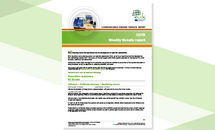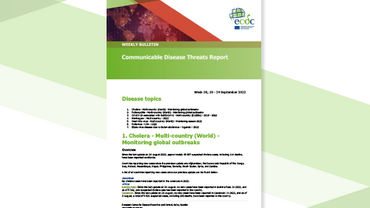Communicable disease threats report, 14-20 February 2016, week 7
The ECDC Communicable Disease Threats Report (CDTR) is a weekly bulletin for epidemiologists and health professionals on active public health threats. This issue covers the period 14-20 February 2016 and includes updates on Zika virus, MERS and seasonal influenza.
Executive summary
This issue covers the period 14–20 February 2016, and includes updates on Zika virus infection, seasonal influenza in Europe and suspected haemolytic uraemic syndrome (HUS) cases in Romania.
Zika – Multistate (world)
Zika virus infections continue to spread to previously unaffected areas of the world.
Several countries in the Americas, Caribbean and the Pacific continue to report an increase in autochthonous cases of Zika virus infection. In the past week, four additional countries or territories have reported laboratory-confirmed autochthonous transmission: Aruba, Bonaire, Marshall Islands and Trinidad and Tobago.
Possible links between Zika virus infection in pregnancy and microcephaly of the foetus have been under investigation since October 2015. The magnitude of the risk that Zika virus infection during pregnancy will result in malformations in the foetus remains unknown at present. However, considering the growing body of evidence of adverse pregnancy outcomes associated with Zika virus infection, ECDC recommends that pregnant women should consider postponing non-essential travel to Zika affected areas.
Read more: Rapid risk assessment on Zika virus epidemic in the Americas: potential association with microcephaly and Guillain-Barré syndrome – second update 6 February 2016
Influenza - Multistate (Europe) - Monitoring 2015–2016 season
During the past week, increasing rates of influenza-like illness (ILI) and acute respiratory infection (ARI) were reported from 21 of 46 countries in the WHO European Region. Belarus, Finland, Greece, Ireland and Switzerland indicated high-intensity influenza activity. Most of the viruses characterised so far have been similar to the strains recommended for inclusion in this winter’s trivalent or quadrivalent vaccines for the northern hemisphere.
Read more: Flu News Europe and Influenza virus characterisation, Summary Europe, December 2015
Haemolytic uraemic syndrome (HUS) cases in young children –Romania
Twelve children aged between 5 and 16 months have been hospitalised in Bucharest and Craiova due to suspected haemolytic uraemic syndrome (HUS). No causative agent has been identified yet. According to the Ministry of Health in Romania, they presented with symptoms of vomiting and diarrhoea, with or without dehydration between 25 January and 9 February. Three of the cases died, three are under dialysis in an intensive care unit, five are admitted in a nephrology ward and one has been discharged.
Two ECDC experts and one EPIET fellow have been deployed to support the outbreak investigation upon request from the Romanian Ministry of Health.
Download






